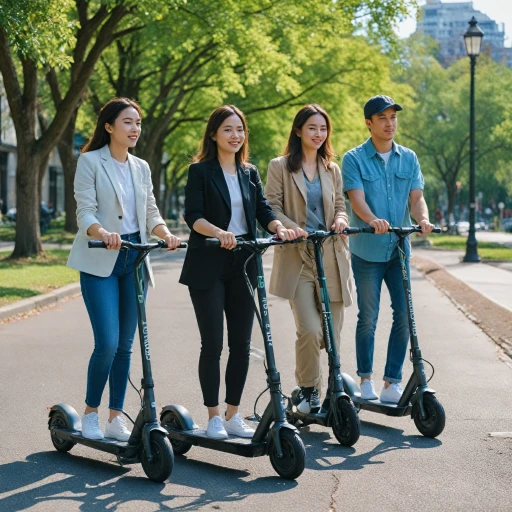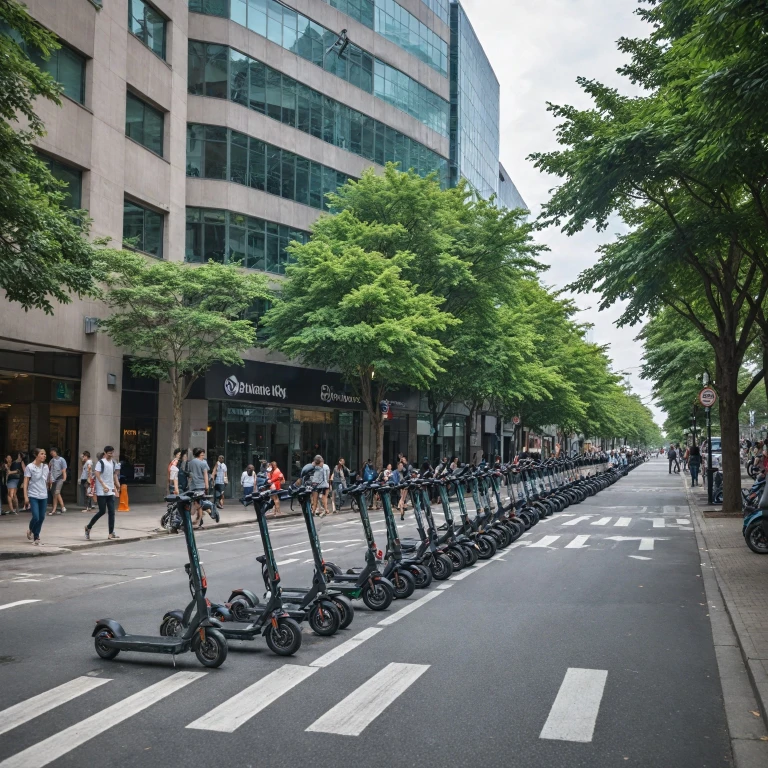Current Legal Status of Electric Scooters
Where Do Electric Scooters Stand Legally?
Electric scooters have surged in popularity across various cities and states, leading to a mixed legal landscape that can be tricky to navigate. Depending on where you are, the legality of riding electric scooters can vary significantly.
In many places, electric scooters are recognized under the same umbrella as bicycles or mopeds, but this is not universally the case. For instance, in York City, electric scooters are permitted on streets with certain limitations, such as speed limits and designated bike lanes. However, other areas may classify them differently in their scooter laws, restricting where they can be ridden and requiring specific safety measures.
Moreover, the maximum speed for electric scooters is often dictated by local regulations. Riders are usually required to adhere to speed limits, often not exceeding 15 to 20 mph in urban areas. Some cities enforce even stricter rules, setting a lower limit mph for scooter riders, especially within congested zones.
An important factor in determining if an electric scooter is street legal involves whether the rider needs a driver license. In certain states, being over a certain age and possessing a license are prerequisites for operating an electric motor scooter.
Finally, wearing a helmet can be a legal necessity in several jurisdictions, particularly for younger riders. Failure to wear helmet can result in fines or penalties, further emphasizing the critical role of safety regulations in the legal discourse surrounding electric scooters.
To explore more about the legal framework governing the use of electric scooters on public roads, and to get familiar with specific laws that could affect you as a rider, you might find this comprehensive guide on understanding the legalities of electric scooters on public roads particularly useful.
Key Factors Influencing Legality
Influencing Factors in Scooter Legislation
Electric scooters have rapidly gained popularity as a green mobility solution, but the laws surrounding their use can be complex and varied. These laws are shaped by several critical factors that cities and states consider when crafting regulations.
- Safety Concerns: Safety remains a primary consideration. Regulations often mandate the use of helmets and specify age limits for scooter riders to minimize personal injuries.
- Speed Regulations: Most laws place strict speed limits on electric scooters, typically capping the maximum speed at about 15 mph. This helps ensure the safety of both riders and pedestrians.
- Infrastructure: Cities like York have to consider their existing infrastructure. Whether scooters are allowed on streets, sidewalks, or bike lanes is determined by city planning needs and the need to maintain a smooth traffic flow.
- Legal Status: Some regions require a driver license to operate electric scooters, while others do not. This variation can significantly impact where and how scooters can be legally ridden.
- Environmental Impact: Many cities are motivated by environmental concerns to embrace scooters as a low-emission transportation option, influencing their legislation towards facilitating scooter use.
Ensuring that scooter laws align with existing state and city traffic codes is crucial to maintaining public safety and order. For further specifics on legislation, examining
electric scooter regulations in different regions can provide a clearer picture of how these factors are prioritized and balanced.
Safety Regulations and Requirements
Key Safety Guidelines for Riding Electric Scooters
Navigating the legality of electric scooters also involves understanding critical safety regulations and requirements that govern their use on the streets. These guidelines not only ensure the safety of the riders but also contribute to minimizing the impact on pedestrians and other commuters.
First and foremost, wearing a helmet is highly emphasized in many jurisdictions. Although some states have made it a legal requirement, it is always recommended to wear a helmet while riding electric scooters to prevent personal injury. Scooter riders should also be aware of the age restrictions imposed by local laws. In certain areas, a minimum age limit is established to ensure that only individuals with adequate judgment and skills are operating these vehicles.
Most states stipulate that electric scooters operate within specified speed limits. This is essential in urban settings like New York City, where riding at high speeds can pose a significant risk to scooter riders and others on the road. Depending on the city or state's regulations, the speed limit can range between 15 mph to 30 mph. Adhering to these regulations is crucial for avoiding accidents and legal infractions.
When considering where to ride, it’s important for riders to know whether scooters are legally allowed on sidewalks, bike lanes, or roadways. Many cities encourage riding electric scooters in designated bike lanes to ensure a smoother and safer flow of traffic. Failing to comply with these regulations can result in fines or even the confiscation of the scooter.
Additionally, some areas necessitate a driver license to operate electric scooters, particularly those that exceed a certain speed mph or have a more powerful electric motor. In states where obtaining a license is a legal prerequisite, it is imperative for riders to familiarize themselves with local ordinances regarding licensing requirements.
For those looking for further guidance on selecting a scooter that aligns with their needs, especially for riders weighing 300 lbs or more, detailed insights are available on
choosing the right electric scooter. Understanding these safety regulations and requirements is essential for responsible and legal operation of electric scooters, ensuring that riders can enjoy a convenient and eco-friendly mode of transportation without legal troubles.
Impact on Urban Mobility and Environment
Impact on Traffic and Environment
Electric scooters have rapidly become a significant feature of urban mobility, influencing the city's traffic and environmental landscape. As more people opt to ride electric scooters, especially in densely populated areas like York City, there is a visible reduction in car usage, contributing positively to the decrease in traffic congestion. This shift can lead to a more streamlined flow of vehicles and less time spent in traffic.
Moreover, the environmental benefits are notable. The transition from traditional gas-powered vehicles to scooters powered by an electric motor helps in reducing carbon emissions, making them a greener transportation option. Cities embracing scooter use encourage eco-friendly travel, contributing to the overall reduction of urban air pollution.
However, the growing presence of electric scooters also presents some challenges. The introduction of scooters into the urban traffic ecosystem necessitates clear regulations concerning where passengers can ride, whether bike lanes or specific scooter paths should be used, and what laws apply to scooter riders. Existing speed limits, usually capped at 15 mph for scooters, are implemented to ensure that these vehicles can safely navigate alongside larger, faster transportation.
The presence of personal injury concerns also calls for laws that mandate the use of appropriate safety gear, such as wearing a helmet, for scooter riders. This is not just about protecting the individual but also about creating a culture of safety and adherence to regulations.
Therefore, while electric scooters offer promising solutions to long-standing urban mobility issues, they also require thoughtful integration into existing traffic systems and environmental policies to maximize their benefits while mitigating potential drawbacks.
Challenges and Controversies
Challenges and Controversies Surrounding Electric Scooters
The legalization of electric scooters on city streets continues to provoke debates and controversies, with several key challenges emerging. Despite efforts to regulate scooters effectively, discrepancies in laws across different states and cities lead to confusion among riders and law enforcement authorities alike.
One significant issue is the inconsistency in speed limits and age requirements. While some areas stipulate a maximum speed of 15 mph, others allow up to 20 mph or more. These variations can create discord in communities, especially where pedestrian safety and traffic flow are areas of concern. Determining appropriate speed limits for different environments, such as dense urban areas or expansive suburban roads, remains a pressing issue.
Moreover, the need for safety gear, like helmets, is another point of contention. Although wearing helmets is encouraged, not all regions mandate it, which raises concerns over personal injury risks. The lack of cohesive laws regarding protective equipment can further exacerbate safety issues for scooter riders. Whether helmets are required can also depend on the rider's age, leading to additional complexity.
Allowing electric scooters to operate on bike lanes has faced opposition in some precincts. While this solution aims to streamline urban mobility, sharing lanes with bicyclists can create conflicts and heighten accident risk. Determining appropriate spaces for electric scooters—be it bike lanes, sidewalks, or streets—poses another layer of challenge for city planners and regulators.
Furthermore, the need for a driver license to ride electric scooters is a subject of debate. Some jurisdictions require motorized scooter riders to hold a valid driver's license, while others do not, leading to varying degrees of enforcement and compliance.
Another issue that cities like New York face is implementing adequate regulations while preserving the benefits of electric scooters, such as reduced traffic congestion and lower environmental impact. Balancing these benefits with the challenges, including regulatory inconsistencies and safety concerns, requires ongoing deliberation and adjustment.
In conclusion, addressing the dilemmas of scooter laws and ensuring electric scooters remain a viable, safe mode of transport necessitates collaboration from lawmakers, city officials, and communities. As we navigate these complexities, input from stakeholders will be crucial in shaping future legislation and enhancing urban mobility.
Future Trends in Electric Scooter Legislation
Emerging Developments and Legislative Innovations
As cities continue to adapt to the environmental and mobility advantages of electric scooters, one can expect adjustments in scooter laws across various regions. In light of the current legal status of electric scooters, government bodies are increasingly recognizing the need to standardize laws and regulations concerning these modern vehicles.
Integration of Smart Technology
With technological advancements, smart integrations such as geo-fencing and real-time tracking are becoming essential to monitoring scooter usage. This technology helps regulate where scooters are allowed, enhancing compliance with riding and speed regulations. For instance, technology can automatically reduce the maximum speed within restricted zones, ensuring adherence to designated speed limits and keeping speed mph in check.
Safety and Infrastructure Development
Safety is a high priority, leading to evolving regulations around helmet use and age requirements. Authorities are also increasingly focused on expanding bike lanes and safe pathways to accommodate electric scooters legally. This infrastructure development not only fosters a safer environment for scooter riders but also aligns with broader urban planning initiatives.
Environmental Considerations and Incentives
Electric scooters contribute to reducing urban congestion and carbon emissions. Future legislation is likely to support this eco-friendly mode of transport by offering incentives for those choosing to ride electric over traditional vehicles. States might introduce programs that encourage businesses and city planning to actively promote scooter usage as part of their environmental strategies.
Ongoing Challenges and Legal Harmonization
While strides have been made, challenges such as personal injury liabilities and clear differentiation between various electric rides persist. Legal frameworks are expected to address these issues by harmonizing laws across state and city jurisdictions, ensuring riders understand their rights and obligations when operating electric scooters.
In summary, the future of electric scooter laws points towards more regulated, safer, and environmentally conscious urban mobility solutions. As changes unfold, staying informed about scooter laws remains crucial for both enthusiasts and regulators alike.

